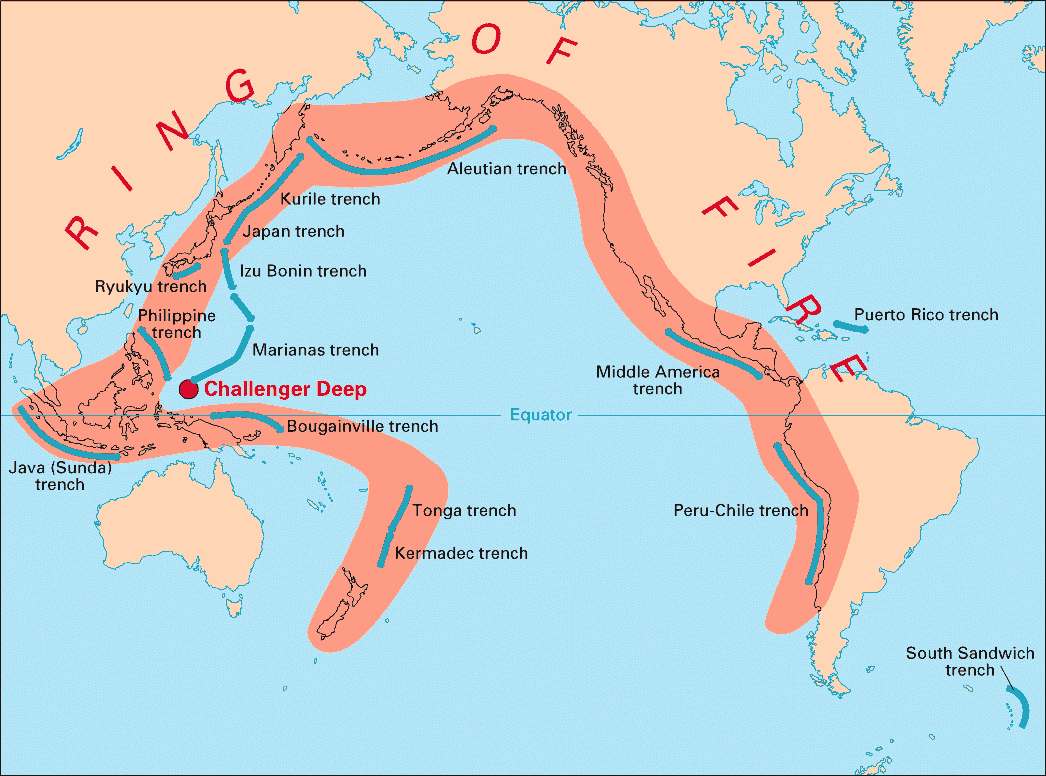An oceanic trench is an extended, tapered depression on the sea floor. It is the lowest regions on the earth. Oceanic trenches are located at the deepest points of the ocean. They form a structure of tectonic processes commonly known as subduction. A trench forms when an oceanic plate subducts a lighter superseding plate (Lee, Lerner, and Brenda Wilmoth Lerner, par 2). The Japan Trench is an example of an oceanic trench. It is located on the floor of the Pacific Ocean, in the northeastern Japan waters. It is approximately 29,500 ft. in length, extending from the Bonin Islands to the Kuril Islands. This trench is located along a zone of earthquake and volcanism in the Pacific Ocean. This zone is called the ring of fire.
The Japan Trench was formed when the pacific plate subducted below the Okhotsk plate. This process involved sinking of tectonic plates into the mantle as they were converging. At the exact point where this occurred, a v-shaped depression was formed resulting to the formation of the trench. This point has high rates of earthquakes, deformations, metamorphism, volcanism, and mountain building (Japan Trench, Izu-Bonin Trench, and Ryukyu Trench, par 1). This point is called a subduction zone.
Subduction zones are found at the boundaries where convergent plates come together. The piece sinks in the surface of the earth at an approximate angle of 45 degrees. The oceanic plate basalt is transformed to eclogite at a depth of about 120km. This result to increase in the density of the oceanic plate, forcing it to move into the mantle. Subduction zones have the sedimentary layers, oceanic plate, earth’s lithosphere, and trapped water that are cast-off into the mantle. Subduction process allows for the existence of the plate tectonics. This process is only known to occur on the planet earth (California Environmental Resources Evaluation System, par 65).
Subduction zones are asymmetric in the first hundreds of miles. As they descent into the oceanic trenches, they become inclined. This results to earthquakes. These earthquakes take place in the deeper parts of the earth. This results to the seismicity on the outer solid earth. During the conversion of basalt to eclogite, a lot of water forms at high temperatures and pressure. This supercritical water then moves to the mantle lowering its pressure of the magma.
This allows for melting of the magma and the ultimate formation of the volcanic eruption as the magma moves to the earth surface. The major effect of the strains resulting from the convergence at the subduction zones are earthquakes and tsunamis. Earthquakes build up in the subducting plates (California Environmental Resources Evaluation System, par 38).
It can be clearly seen that, the Japan Trench is responsible for the many calamities that have befallen Japan in the recent years. It is impractical to dispute the facts about how the geological location of Japan predisposes it to the earthquakes and the tsunamis.
There are also positive effects that come with the presence of subduction zones in a region. The force needed to allow for the movement of the plates in the plate tectonics is generated from plummeting of oceanic lithosphere. Through the release of water from subducted sediments, the mantle melts; this produces continental crust and islands. The ability of the subduction zones to pull down the oceanic segments, results to high temperatures in the mantle releasing the continental crust and the ore deposits.

Works Cited
“California Environmental Resources Evaluation System (CERES).” 2003, California Resources Agency. Web.
Lee, Lerner, and Brenda Wilmoth Lerner. “World of Earth Science.” Vol. 2. Gale Cengage, 2003. Web.